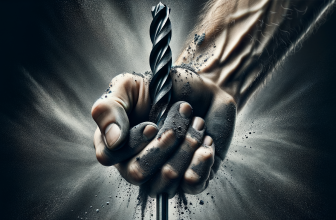
Are you on the lookout for a reliable bench grinder to shape, sharpen, or smoothen materials in your workshop? This power tool is fundamental for any craftsman seeking precision and efficiency in their work. Whether you are a professional tradesperson or a dedicated DIY enthusiast, choosing the right bench grinder for your needs is critical for the success of your projects.
Our Top Picks
Our #1 Top Pick: DeWalt DW758 8-Inch Bench Grinder
When it comes to combining power, durability, and performance, the DeWalt DW758 8-Inch Bench Grinder sits at the pinnacle of our list. Equipped with a powerful 3/4 HP induction motor, it runs at an impressive 3,600 RPM which makes quick work of any grinding operation. The rugged cast iron base and motor housing ensure both stability and longevity. Moreover, the tool comes with rear exhaust ports in the wheel guards for a smoother operation. Two 8-inch grinding wheels with different grits provide versatility for both coarse and fine grinding. Users appreciate its overload protection, which enhances motor life and ensures dependable performance.
Pick #2: WEN 4276 2.1-Amp 6-Inch Bench Grinder
If you’re searching for efficiency at an affordable price, the WEN 4276 is an excellent choice. This 6-Inch, 2.1-Amp bench grinder comes with a flexible work light to illuminate your work area, which is especially helpful for detailed tasks. While it may not be the most potent option on the market, it offers more than enough power for the average homeowner or hobbyist. The two grinding wheels provided allow for both general-purpose grinding and more precise sharpening. Plus, with its quiet operation and smooth performance, it’s a delight to work with on smaller jobs.
Pick #3: Jet 577102 JBG-8A 8-Inch Bench Grinder
For the professional seeking a robust addition to their workshop, the Jet 577102 JBG-8A is an investment that pays off. Its heavy-duty construction speaks to the quality Jet is known for. A strong 1 HP motor produces wheel speeds of 3,450 RPM, which can handle the most demanding grinding tasks. The industrial-grade 8-inch grinding wheels come with a 36 and a 60 grit for versatility, and the large eye shields and adjustable tool rests make operation safe and comfortable.
Despite the higher price point, this model’s reliability and power make it a favorite among professionals.
Pick #4: Baldor 662R 6-Inch 1/3-Horsepower Industrial Duty Big Red Grinder
Baldor is synonymous with quality, and the 662R Big Red Grinder is no exception. This 1/3 horsepower unit isn’t just durable; it’s designed for continuous use. It features a 6-inch grinding wheel that might be smaller than others, but what it lacks in size, it makes up for in muscular efficacy. The unit’s heavy-duty construction prevents vibration, providing a smoother operation. It also includes exhaust-type wheel guards for dust and debris control. This bench grinder earns its spot due to its straightforward operation and industrial-grade performance.
Pick #5: Craftsman 9-21154 Variable Speed 6-Inch Grinding Center
The Craftsman 9-21154 stands out for its variable speed feature, allowing users to choose from 2,000 to 3,450 RPM to suit various grinding tasks. It’s a versatile and user-friendly tool fit for both DIY enthusiasts and craftspeople alike. The grinder comes with wide, clear eye shields and sturdy cast iron base to enhance stability and maintain clear visibility. Craftsman’s patented tool-free adjustable guard allows for quick and easy installation and adjustments. In-built cool-down trays and a water cooling tray make this grinder a suitable option for extended use, reducing the risk of overheating.
What to Know Before You Buy
- Grinder Size: Bench grinders typically come in two sizes, 6-inch and 8-inch. Your choice depends on the intended use. Larger grinders have more power and are suited for bigger, more industrial tasks, while smaller grinders are perfect for lighter workloads.
- Motor Power: The power of the motor determines the grinder’s capability. More horsepower means the grinder can handle harder materials and longer usage sessions without overheating or bogging down.
- Wheel Speed: Noted in revolutions per minute (RPM), the wheel speed affects the effectiveness of grinding. Higher speeds enable quicker material removal but may also produce more heat.
- Durability: The construction material and design of the grinder play a pivotal role in how well it can stand up to repeated use. Heavy-duty materials like cast iron bases help reduce vibration and improve stability.
- Adjustability: Look for features like adjustable tool rests and protective eye shields for both safety and precision in grinding.
Factors to Consider Before Buying
- Workload: Assess the type of materials you’ll be working with and the frequency of use. This will help determine the size and power of the grinder you need.
- Wheel Types: Grinding wheels come in varying types of grit and materials such as aluminum oxide or silicon carbide. Choose them based on the tasks you plan to perform.
- Variable Speed: Having the option to adjust speed can be critical for tasks requiring more finesse or those that may be prone to overheating.
- Brand Reputation and Warranty: It’s generally a good idea to invest in tools from reputable brands that offer warranties, as this speaks to the quality and durability of their products.
- Safety Features: Eye shields, dust collection systems, and spark arrestors are a few safety features that can protect you from common hazards associated with grinding operations.
- Price: Bench grinders can vary widely in price. Consider your budget, but don’t sacrifice necessary features for a lower price tag.
Why Trust ChooseRight?
We, at ChooseRight, take product evaluation seriously, which is why our reviews are trusted by many. Before recommending any bench grinder, we meticulously scrutinize numerous products, pore over reviews written by thousands of real users, and seek insights from professionals in the field. Only after we’ve completed this extensive research do we make our conclusion, ensuring that you only get the most reliable and effective recommendations to assist in your purchase decision.
Finishing Thoughts
Selecting the best bench grinder for your needs is more than just buying a tool; it’s about investing in your craft, your safety, and your efficiency at work. In our comprehensive guide, we have walked you through the top choices on the market, discussed the key features to look for, and shared the methodology behind our vigilant review process. With this information at your disposal, the decision-making process should be significantly less daunting now. Remember that the best bench grinder will align with your work requirements and budget constraints, all while improving the craftsmanship of your projects.
Frequently Asked Questions
What are the main uses of a bench grinder?
A bench grinder is primarily used for sharpening cutting tools, such as chisels, drill bits, and knives. It can also be used for shaping metal parts before welding or fitting, cleaning objects by removing rust or burrs, and polishing metal surfaces for a smoother finish.
What should I consider when choosing a bench grinder?
When selecting a bench grinder, you should consider its power, size of the grinding wheels, speed (RPM), type of grinding wheels, adjustability of tool rests, spark guards, dust extraction capabilities, build quality, and brand reputation. The choice will depend on the specific tasks you plan to use the grinder for and the frequency of use.
How do I safely operate a bench grinder?
To safely operate a bench grinder, always wear safety goggles or a face shield to protect your eyes, use appropriate gloves to protect your hands, and ensure that tool rests are adjusted close to the wheels. Stand to one side when starting the grinder, let it reach full speed before grinding, do not apply excessive pressure on the tool or workpiece, and never grind small pieces that might get caught between the rest and the wheel.
Can I use a bench grinder to sharpen woodworking tools?
Yes, you can use a bench grinder to sharpen woodworking tools, but it is important to use the correct grinding wheel and technique to avoid overheating and damaging the tool’s temper. It’s recommended to use a slower speed grinder or a wet grinding wheel for precision sharpening.
How often should I replace the grinding wheels on my bench grinder?
The lifespan of grinding wheels on a bench grinder depends on their use and condition. Inspect them regularly for cracks and wear and replace them when they appear to be worn out or damaged. Make sure they’re properly dressed to maintain their shape and performance.
Can I use a bench grinder for polishing materials?
Yes, with the appropriate wheels or buffing pads, a bench grinder can be used for polishing metals and other materials to achieve a high-gloss finish.
What is the difference between a 6-inch and an 8-inch bench grinder?
The primary difference between a 6-inch and an 8-inch bench grinder is the size of the grinding wheels. An 8-inch grinder typically has larger wheels and a more powerful motor, which allows for the tool to run smoother, particularly under heavier use, and enables it to handle larger or thicker items on a regular basis.
How do I maintain my bench grinder?
To maintain your bench grinder, keep it clean and free from metal dust and debris, inspect and adjust the tool rests as needed, lubricate moving parts, check for and replace worn-out parts, and ensure that grinding wheels are dressed correctly and replaced when necessary.
Is variable speed important in a bench grinder?
Variable speed can be an important feature for a bench grinder, as it allows for greater control over the sharpening and grinding processes, especially for delicate tasks that require precision, or when working with materials that might burn or discolor at high speeds.
Should I choose a bench grinder with or without a work light?
This choice depends on your workspace lighting conditions. A work light can be very useful if you often work in a poorly lit area or if you need focused lighting on the workpiece to ensure precision in your tasks. If you already have ample overhead lighting, the built-in light might not be necessary.







